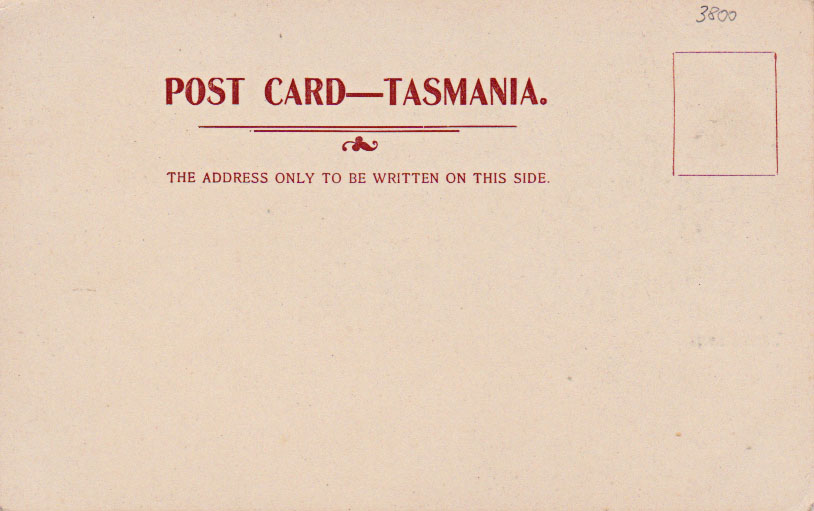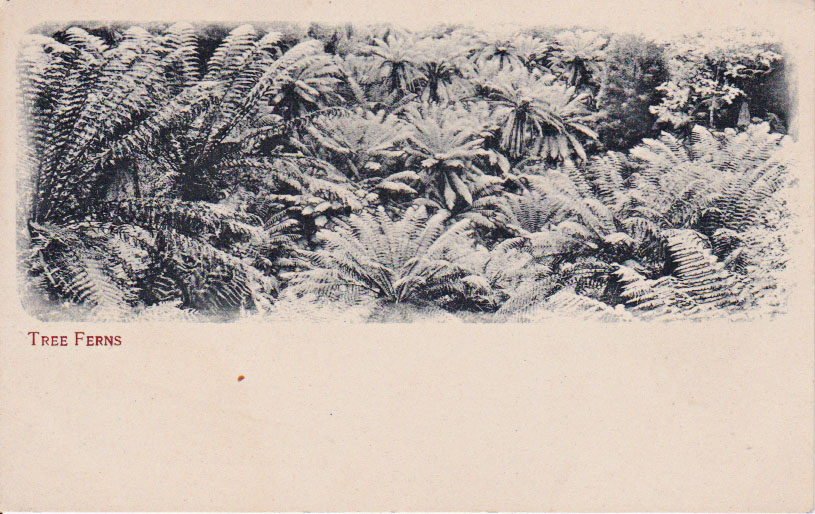This was Walch's first series of picture postcards. They are undivided back cards.
Series Contents and Date Published: The series was announded in Walch's Literary Intelligencer (Note 1) in the issue of January 1900. They said:
"We have just published a series of Six Post Cards, containing on each Post Card a beautifully executed view of Tasmanian Scenery. The views are perfect gems of art, and nothing could be better designed for "Advertising Tasmania". Packets of six, Ninepence, posted Tenpence."
In the February 1900 issue of Walch's Literary Intelligencer they listed the six cards in the set:
- Hobart from the Harbour
- Huon Road, with Mount Wellington
- Bank of Tasmanian Ferns
- Cape Raoul from the Sea
- Government House
- Walch's Corner, LIverpool Street
Printing: Printed by collotype by the British Photoprint Company.
Number in Series: 6

Identification: The front of the cards have a vignetted black & White image, with a caption in red below. The publisher is not identified anywhere on the card.
The undivided back has "POST CARD - TASMANIA." in a heavy, red printing, with two lines below, and under that a curly symbol that is unique to this series. The stamp box is of thin solid lines.
History: We have a good record of the history of these postcards from letters preserved in the Archives Office of Tasmania. Walch & Sons in Hobart retained a business agent in London, Mr Charles Holworthy. Walch's letters to Holworthy are not available, but Holworthy's letters back to Hobart and to suppliers in England and on the Continent have been preserved.
The first time postcards are mentioned is in Holworthy’s letter to Hobart of November 1898, (Note 2) when he said that he had got a printing quotation from Stewart’s and has sent a sample of their work to Hobart. Later in November Holworthy reported that a sample was sent from a printer in Amsterdam, and a quotation requested from the British Photoprint Co. (who were the printers eventually selected). In December he reported sending a sample from the British Photoprint Co. and gave information on prices for printing various quantities. In 7 April 1899 (Note 3) he gave more details on the prices of the British Photoprint Co. and detailed their requirements:
"A negative is not really necessary. They can work with a good clear silver print of sepia tint and prefer this to a negative. Size must not be less than ½ plate, but a whole plate print for preference.
10,000 cards 25/- per thousand 20,000 @ 22/6 per thousand. They are now doing a lot of these cards for advertisements, one or two of which I enclose. The rage for these cards in England and from the Continent is enormous & still increasing. I suppose there would be a large sale to passengers from England to New Zealand if you publish a series of Tasmanian views. I hear on all sides that it is the fashion to collect these cards now, this of course increases the sales."
An order for printing cards was apparently placed, but in his letter of 7 July 1899, Holworthy indicates that the order has been cancelled. But then in his letter of 15 September 1899, he said:
"I had for safety put your photos and papers bearing on the order for View Cards in the safe, so that I soon had the order written out with full instructions. I took it round to the British Photoprint Co. and explained our position and although they never promise an order under a month I should not be at all surprised if I get them in time to ship by the steamer due in Hobart 6 December. The manager promised to use every effort to get them ready in time. Of course the coat of arms in the address side cannot be put on, as it is against the law except when done for the government."
The cards were apparently then printed, as Holworthy, in his letter of 10 November 1899 wrote:
"Postcards: I enclose samples of them but regret they were a day or two late for the “Paparoa”. I am a little disappointed with them but people I have shown them to in the City say ‘How good & pretty”. “Tree Ferns” (if I remember the subject) has been done very badly. I must see the company about it on Monday, tomorrow is payday."

There wasn’t really a problem with the tree ferns, as Holworthy wrote on 26 January 1900 (Note 4):
"When I wrote about the Tree Fern view post card as being very bad, I was under the impression that in executing the order the company had cut off all the stems from the tree ferns leaving only the leaves. The title seemed almost a misnomer, as there was hardly any of the tree to be seen, but when I complained they showed me the photo & I see it is executed as sent. I think therefore you will be satisfied with the general finish of the work."
Walch & Co must have written back to Holworthy, as on 1 February 1900 Holworthy wrote:
"I hope these will sell rapidly, of course the result so much depends on the subject, of the photo, the clearness of the negative or photo & the weather."
Walch & Co. in Hobart must have sent some cards back to Holworthy, because on 9 March 1990 he wrote:
" I have sent on your claim for shorts and spoiled copies of the view cards, I am glad to hear they are going off fairly well."
Later, Holworthy noted that British Photoprint Co. had allowed a credit of six shillings and tenpence! (Walch and Co. were always watching the pennies).
Note 1: Walch's Literary Intelligencer was a monthly advertising publication published by J. Walch & Sons. It is held by the State Library of Tasmania as hardcopy and as microfilm
Note 2: Archives office of Tasmania NS2857/1/5 Letters from the London Office 1898
Note 3: Archives office of Tasmania NS2857/1/6 Letters from the London Office 1899
Note 4: Archives office of Tasmania NS2857/1/7 Letters from the London Office 1900
